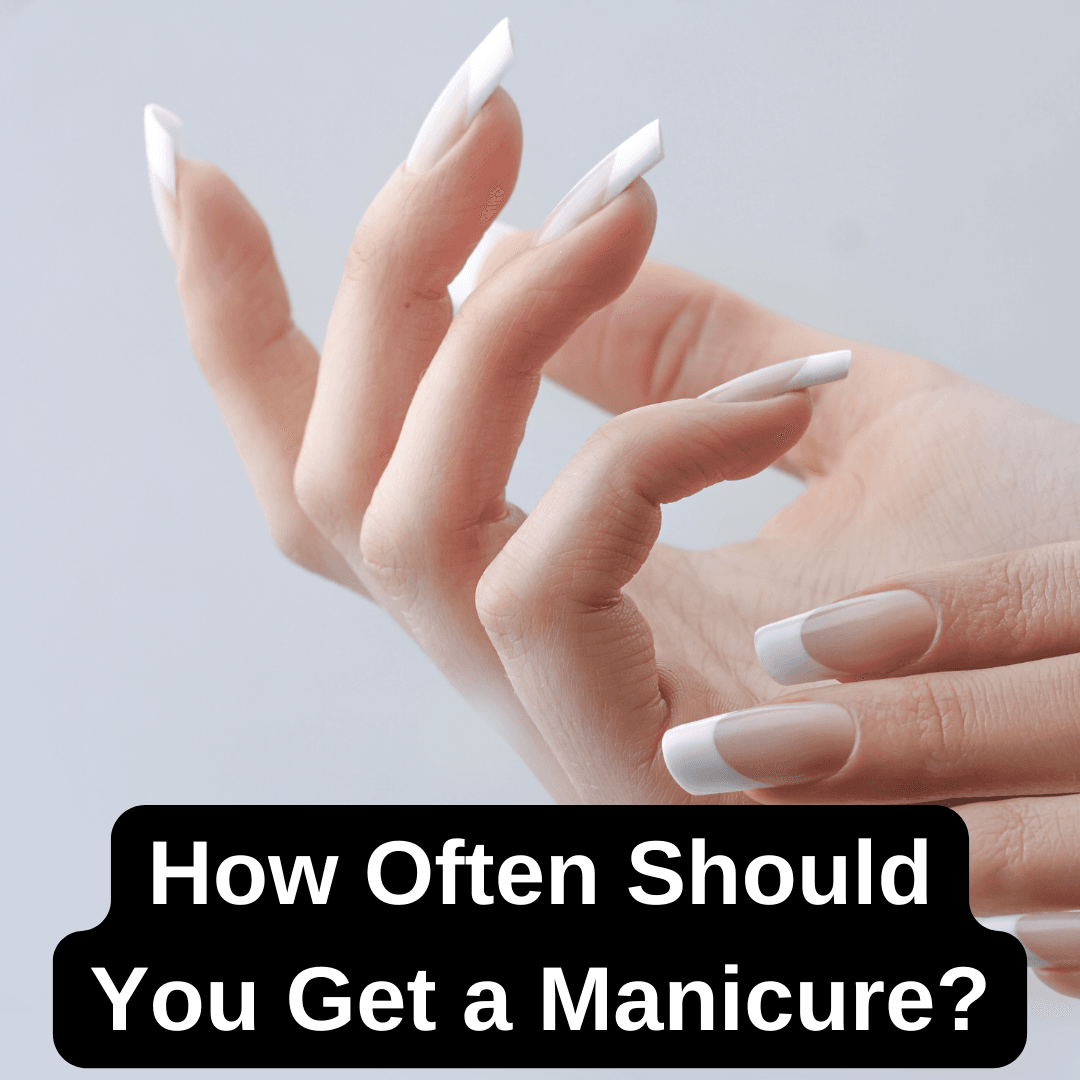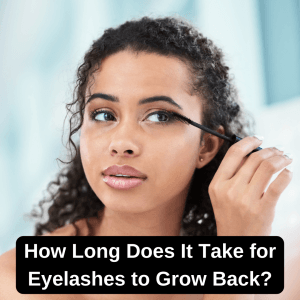Maintaining well-groomed nails goes beyond aesthetics — it’s essential for promoting healthier nails and preventing long-term damage. Whether you prefer a classic manicure, opt for a trendy gel finish, or experiment with acrylics, understanding how often you should schedule a manicure ensures both beauty and nail health. If you’re unsure how frequently you should schedule a manicure, following expert advice can help you maintain healthier nails. According to the American Academy of Dermatology (AAD), regular moisturizing and avoiding harsh chemicals can significantly improve nail strength and prevent breakage.( https://www.aad.org/public/everyday-care/nail-care-secrets/basics/healthy-nail-tips )
So, how often should you get a manicure? The answer depends on factors such as the type of manicure, your lifestyle, and how well you care for your nails between sessions.
Standard manicures typically last 7 to 10 days, while gel or acrylic manicures can stay intact for 2 to 3 weeks. If you’re seeking long-lasting results, choosing the right type of manicure and maintaining it properly can make a significant difference.
Factors That Affect How Often You Should Get a Manicure
1. Type of Manicure
Different types of manicures offer varying lifespans and require different maintenance routines. The durability of your manicure will influence how often you need touch-ups or replacements.
- Regular Manicure: Typically lasts 7 to 10 days before noticeable chipping. Ideal for those who prefer frequent polish changes.
- Gel Manicure: Provides a longer-lasting, chip-free finish for 2 to 3 weeks but may weaken the nails if applied too frequently.
- Acrylic Manicure: Offers durability and can last up to 3 weeks, but requires a fill every 2 to 3 weeks to maintain a polished look.
2. Nail Growth and Health
The rate at which your nails grow and their overall health play a significant role in determining how often you should schedule a manicure. Healthy nails grow approximately 3 millimeters per month, but growth can vary depending on diet, hydration, and general nail care practices.
- Fast-Growing Nails: May require more frequent touch-ups to prevent uneven polish and chipping.
- Brittle or Weak Nails: Benefit from occasional breaks between manicures to restore strength.
For those seeking a perfect balance between nail growth and polish longevity, understanding how many coats of nail polish you should apply ensures a smooth and flawless finish that lasts longer.
Nail growth rate varies depending on health factors, much like how much does hair grow in a month, which is influenced by diet, hydration, and overall care.
3. Lifestyle and Habits
Your daily routine directly impacts how often your manicure lasts. Exposure to water, harsh chemicals, or manual work can accelerate chipping and reduce the lifespan of your manicure.
- Active Lifestyle: If you frequently wash dishes, exercise, or engage in manual labor, expect your manicure to wear out faster.
- Minimal Wear and Tear: If you avoid harsh tasks or protect your nails with gloves during chores, your manicure can last much longer, reducing the need for frequent visits to the salon.
Did You Know? Protecting your hands during daily tasks can preserve your manicure and minimize chipping. Moisturizing regularly and avoiding excessive water exposure can keep your nails healthier and prolong polish longevity.
If your daily routine involves frequent hand washing or manual work, similar to maintaining facial grooming habits like how to get rid of a unibrow, you may need more frequent manicures to keep your nails in top shape.
What Happens If You Get Manicures Too Often?
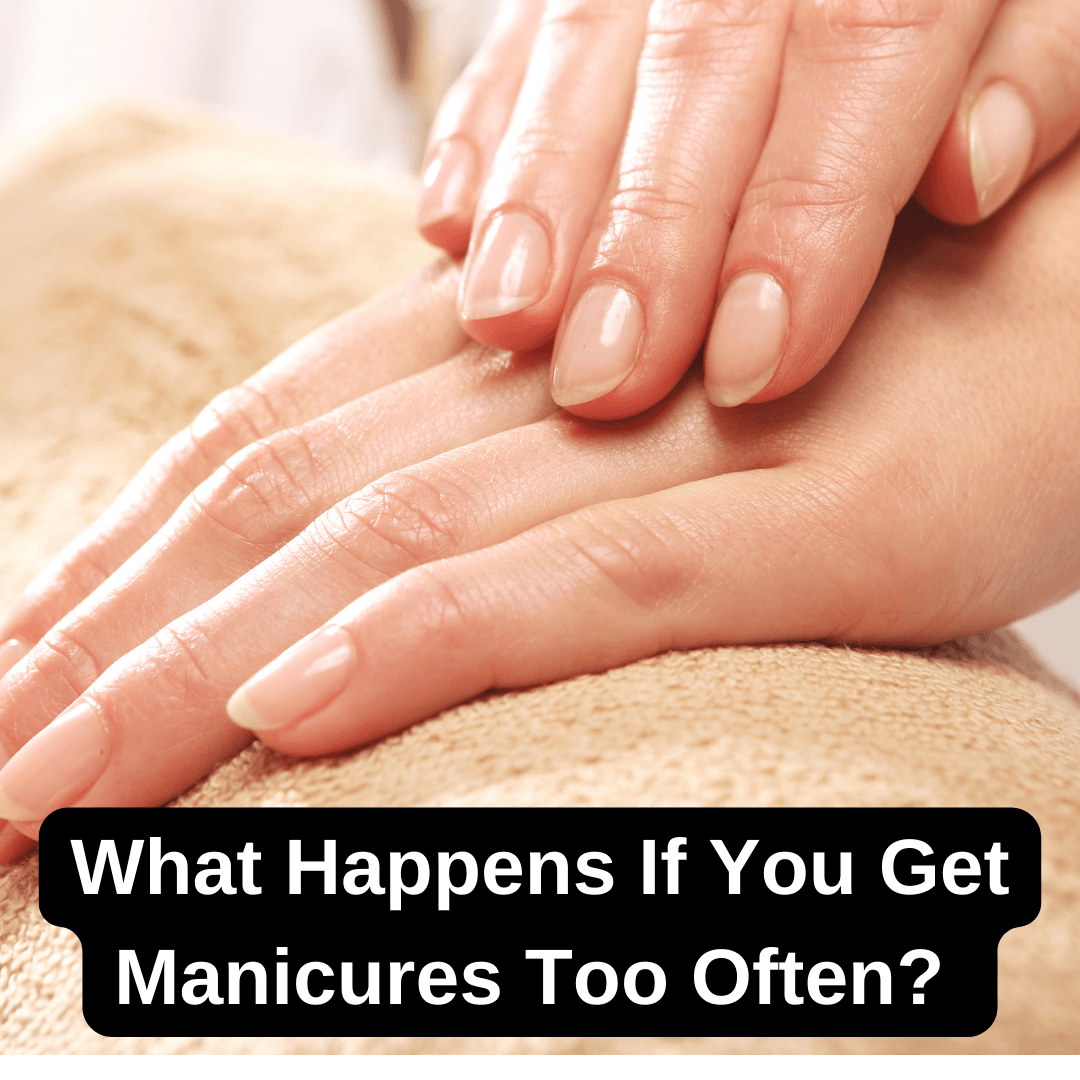
While regular manicures keep your nails looking polished and well-maintained, excessive manicuring can weaken the nail bed over time. Repeated exposure to acetone and other harsh chemicals used during polish removal can dry out your nails, leading to brittleness and peeling. Additionally, aggressive buffing and filing can thin the nail plate, making it more prone to damage.
To protect your nail health, consider taking occasional breaks between manicures, especially if you frequently opt for gel or acrylic finishes.
Overdoing manicures, much like excessive washing and exfoliating your face, can strip away essential moisture and leave your nails brittle.
How Long Should You Wait Between Manicures?
To maintain healthy nails, waiting between manicures is crucial. For regular manicures, a 1 to 2-week interval is ideal to allow the nails to breathe and regain moisture. If you prefer gel or acrylic manicures, waiting 2 to 3 weeks between sessions helps prevent excessive stress on the nail bed and minimizes the risk of nail thinning.
During these breaks, applying a nourishing cuticle oil and using a nail strengthener can promote healthier, stronger nails. If you’re using gel or acrylic, ensure that you take longer breaks every 8 to 12 weeks to give your nails enough time to recover fully.
Signs You Need a Manicure
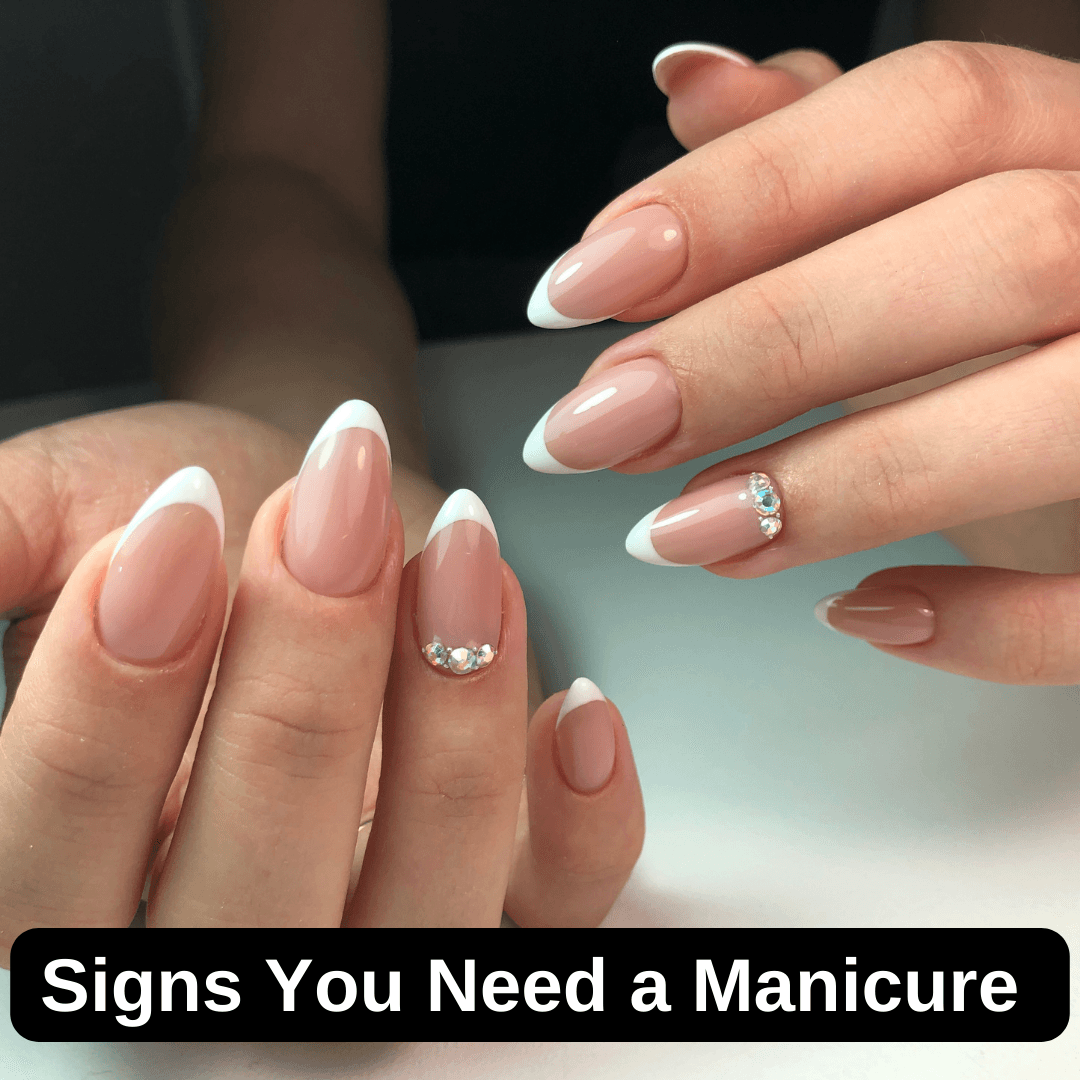
Even if you maintain a consistent manicure schedule, certain signs indicate that it’s time for a new session. Look out for the following signs:
- Chipped or peeling polish
- Brittle or dry nails
- Visible cuticle overgrowth
- Discoloration or uneven texture
If any of these signs appear, scheduling a manicure can restore the natural shine and strength of your nails. Regular manicures also help prevent minor issues from developing into bigger problems, such as splitting or fungal infections.
How Often Should You Get a Gel Manicure?
Gel manicures provide a long-lasting, chip-free finish, making them a popular choice. However, due to the curing process under UV or LED light and the use of acetone for removal, they require a different maintenance schedule. Ideally, gel manicures should be done every 2 to 3 weeks to prevent lifting and maintain a flawless appearance.
Important Tip: Since gel manicures can thin the nails over time, it’s essential to take breaks between sessions to allow the natural nail to recover. If you notice excessive thinning or peeling after multiple gel manicures, it’s best to switch to a breathable formula or opt for a regular manicure for a few weeks.
How Often Should You Take a Break from Manicures?
Taking breaks from manicures is vital for long-term nail health. For regular polish, a break every 8 to 12 weeks allows your nails to regain their natural strength. For gel or acrylic manicures, breaks are even more important, as the chemicals and UV exposure involved can weaken the nail bed over time.
During these breaks, nourish your nails with a hydrating cuticle oil and a strengthening base coat. This routine helps restore moisture and strength, preventing brittleness and peeling. Regular breaks from intense manicure routines ensure healthier, stronger nails in the long run.
Is It Okay to Get a Manicure Every Week?
Yes, weekly manicures are safe if performed with care. However, frequent use of harsh nail polish removers and exposure to acetone can lead to dryness and peeling. If you prefer weekly manicures, it’s best to alternate between regular polish and a breathable, non-toxic formula to minimize potential damage.
Expert Advice: To further protect your nails, choose polishes that are free of harmful chemicals such as formaldehyde, toluene, and DBP. Additionally, keep your cuticles hydrated with a nourishing oil between sessions to prevent dryness and irritation.
Getting weekly manicures is generally safe, but just as is it bad to wax your face can have pros and cons, overdoing it may lead to weakened nails.
How to Make Your Manicure Last Longer?
Achieving a long-lasting manicure requires proper aftercare and maintenance. Follow these tips to extend the lifespan of your manicure:
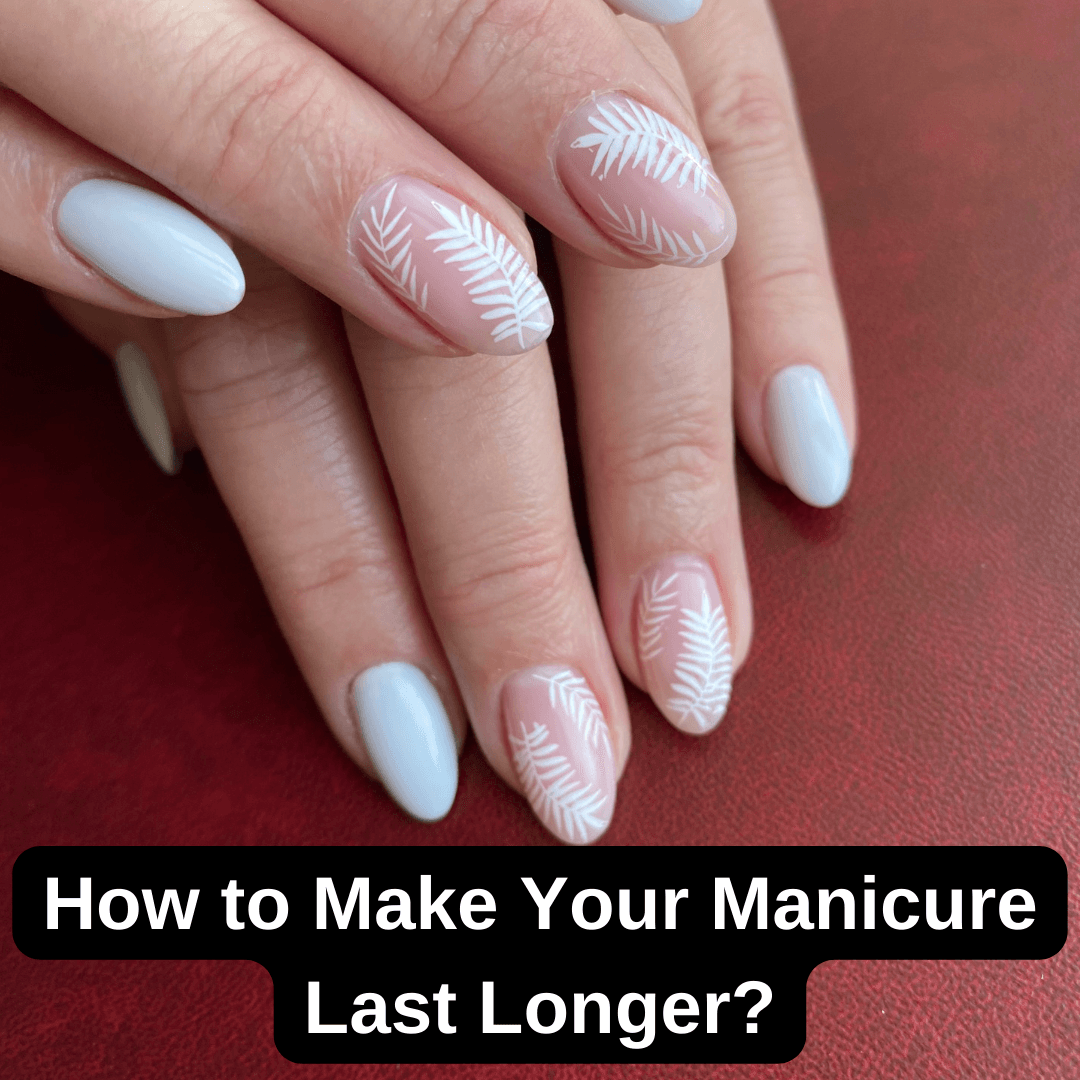
1. Apply a Top Coat Regularly
Reapplying a top coat every 2 to 3 days creates an extra protective layer that prevents chipping and extends the life of your manicure. Opt for a high-quality, long-lasting top coat that adds shine and strengthens the polish.
2. Avoid Excessive Water Exposure
Water weakens the bond between the polish and the nail, causing premature chipping. To prevent this, wear gloves while washing dishes or performing household chores. Prolonged exposure to water can soften the nail bed, making it more prone to damage.
3. Moisturize Your Cuticles
Keeping your cuticles hydrated prevents dryness and peeling, which can cause polish to lift prematurely. Use a nourishing cuticle oil or hand cream daily to maintain hydration and protect the nail bed from becoming brittle.
To extend the longevity of your manicure, adopting a daily nail care routine can make a noticeable difference. A simple 2-minute daily routine recommended by experts helps prevent chipping and keeps your nails hydrated, ensuring a flawless finish for longer. ( https://www.realsimple.com/daily-nail-care-routine-8746256 )
FAQ Section: Most Asked Questions About Manicures
How Do I Know If I Need a Manicure?
You may need a manicure if you notice any of the following signs:
- Chipped or peeling polish
- Brittle or weak nails
- Excessive cuticle overgrowth
- Discoloration or uneven nail texture
If your nails look dull or feel rough to the touch, a manicure can restore their natural smoothness and shine. Regular manicures also help maintain the strength and overall health of your nails, especially if you frequently apply nail polish or gel. If your nails show persistent signs of dryness or weakness, applying a nourishing cuticle oil between manicure sessions can improve their condition.
If your nails show signs of brittleness and discoloration, similar to understanding why eyebrows fall out, it may indicate that a manicure is overdue.
Is It Healthier to Wear Nail Polish or Not?
Wearing nail polish occasionally is generally safe, but taking regular breaks between applications promotes healthier nails. While polish can act as a protective barrier that prevents nails from breaking, frequent use—especially with harsh formulas—can lead to dryness and brittleness.
Best Practice: To maintain optimal nail health, alternate between regular polish and breathable formulas. Taking a break from nail polish every 8 to 12 weeks gives your nails a chance to recover and prevents thinning or peeling.
Are Nails Healthier Without Polish?
Yes, nails are generally healthier when left bare for extended periods. Without polish, the nail plate retains its natural moisture balance, preventing dehydration and brittleness. Leaving nails polish-free for a few weeks allows them to breathe and promotes natural growth.
Expert Advice: Avoid applying polish immediately after removing gel or acrylics, as the nails are often more vulnerable during this period. Give your nails at least 1 to 2 weeks to recover and apply nourishing treatments such as cuticle oil to restore hydration.
What Is the Healthiest Manicure to Get?
The healthiest manicure option is a waterless manicure, which skips soaking and minimizes the risk of bacterial contamination. Traditional soaking can weaken the nail bed, making nails more prone to breakage. Additionally, using non-toxic polishes that are free of harmful chemicals such as formaldehyde, toluene, and DBP helps maintain stronger and healthier nails.
Other Healthy Options:
- Breathable Polishes: Allow oxygen and moisture to pass through, promoting healthier nails while preventing dryness.
- Dip Powder Manicures: Less damaging than gel manicures, but frequent use should be avoided to prevent thinning of the nail bed.
What Is the Best Manicure to Keep Your Nails Healthy?
The best manicure for maintaining healthy nails is a regular manicure that uses natural, non-toxic polishes and focuses on hydration and strengthening. Applying a nourishing base coat before polish and finishing with a cuticle oil locks in moisture and protects the nail bed. This combination helps prevent peeling, breakage, and dehydration.
Avoid excessive buffing, as it can thin the nail plate and lead to increased sensitivity.
What Type of Manicure Is the Least Damaging?
The least damaging manicure options are soft gel manicures and breathable polish manicures. These options minimize nail damage by avoiding harsh chemicals and reducing excessive buffing.
Why It’s Better:
- Soft Gels: Easier to remove than traditional gels, reducing the risk of nail thinning. Soft gels adhere to the nail surface more gently and can be soaked off without extensive buffing or filing.
- Breathable Polishes: Allow air and moisture to pass through, preventing the nail from becoming dry and brittle.
If you’re seeking a long-lasting yet gentle option, these methods preserve nail health while providing a polished finish.
Is Gel Polish Bad for Your Nails?
Gel polish is not inherently harmful to nails, but improper application and removal can lead to serious damage. Peeling off gel polish or removing it incorrectly can strip the nail’s natural layers, causing thinning, brittleness, and increased sensitivity. Consistent use of gel polish without proper aftercare can also dehydrate the nail plate.Best Practice: Always soak off gel polish using acetone to avoid peeling or forcing it off. This prevents unnecessary damage and maintains the integrity of the nail. Additionally, applying cuticle oil regularly helps to counteract the drying effects of acetone and keeps the nails hydrated. If you’re looking for less damaging alternatives, exploring breathable polish options can protect nail health.
What Makes Nails Grow Super Fast?
Healthy nail growth can be encouraged through a balanced diet rich in biotin, vitamin E, and iron. Biotin supplements, in particular, have been proven to increase nail thickness and accelerate growth. Consuming nutrient-dense foods such as eggs, almonds, and spinach can also strengthen the nails from within. Massaging your cuticles with nourishing oils like jojoba or argan oil stimulates blood circulation, enhancing nutrient delivery to the nail matrix. This practice not only promotes faster nail growth but also prevents dryness and breakage. For additional growth benefits, maintaining a consistent cuticle care routine can make a noticeable difference.
Does Olive Oil Help Nails Grow?
Yes, olive oil is packed with vitamins, antioxidants, and essential fatty acids that nourish the nail bed, strengthen the cuticles, and promote healthier nail growth. Regular application of warm olive oil can improve nail flexibility, reduce brittleness, and prevent breakage.
How to Use:
- Warm the Olive Oil: Slightly heat the olive oil until it’s comfortably warm.
- Soak Your Nails: Immerse your nails in the warm olive oil for 10 to 15 minutes.
- Massage Gently: Massage the oil into the nails and cuticles to enhance absorption and stimulate blood circulation.
For best results, repeat this process 2 to 3 times a week. This method is an excellent natural remedy to boost nail growth and prevent common nail concerns.
How to Remove Yellow from Nails Naturally?
Yellowing of the nails can occur due to prolonged use of dark-colored nail polishes or exposure to chemicals. Fortunately, natural remedies can effectively lighten nail discoloration and restore their original color. A mixture of baking soda and hydrogen peroxide works as an effective stain remover, gently lifting stains while brightening the nail surface.
Steps to Remove Yellow Stains:
- Mix the Ingredients: Combine 1 tablespoon of hydrogen peroxide with 2 tablespoons of baking soda.
- Apply the Paste: Spread the paste evenly on your nails and leave it on for 5 to 10 minutes.
- Rinse and Moisturize: Rinse thoroughly with warm water and follow up with a moisturizing cuticle oil.
Alternative: Lemon juice and white vinegar can also naturally lighten yellow stains when applied consistently over time.
Natural remedies like baking soda and peroxide work similarly to alternative methods such as sugar wax without lemon, offering gentle solutions for beauty concerns.
Why Do Nails Turn Yellow?
Nails can turn yellow due to several factors, including prolonged use of dark-colored polishes, fungal infections, smoking, and poor nail hygiene. Pigments in dark polishes penetrate the nail plate over time, causing discoloration. Additionally, exposure to harsh chemicals and inadequate nail care can exacerbate yellowing.
Prevention Tips:
- Use a Base Coat: Apply a protective base coat before using dark polishes to prevent staining.
- Limit Polish Duration: Avoid leaving polish on for extended periods to prevent long-term discoloration.
- Maintain Nail Hygiene: Clean and moisturize your nails regularly to prevent fungal infections and staining.
If yellowing persists despite regular care, it may be beneficial to explore deeper treatments or consult a dermatologist for potential fungal infections.
What Is the Most Flattering Nail Polish Color?
The most flattering nail polish color varies based on skin tone, but neutral shades such as nude, pale pink, and classic red tend to complement most skin tones and enhance the natural beauty of the hands. These colors provide a timeless, elegant look suitable for any occasion.
Best Choices by Skin Tone:
- Fair Skin: Light pinks, soft nudes, and beige tones offer a subtle, refined look.
- Medium Skin: Coral, warm reds, and mauve shades complement medium tones and add warmth.
- Dark Skin: Deep plums, rich reds, and metallic shades create a bold, glamorous finish.
Choosing a polish that matches your undertone enhances the natural beauty of your hands while providing a polished and sophisticated look. For special occasions or longer-lasting results, opting for gel polish in complementary shades can elevate your nail game.
Choosing the right nail polish color is similar to understanding the benefits of rose water, where the right choice enhances overall beauty.
What Type of Manicure Lasts the Longest?
The longest-lasting manicure is a gel manicure, which can stay chip-free for up to 2 to 3 weeks. Gel polish is cured under a UV or LED lamp, creating a durable, glossy finish that resists chipping and peeling. Dip powder manicures also offer long-lasting results, often lasting around 3 weeks or more with proper care.
Avoid exposing gel manicures to excessive water or harsh chemicals to extend their longevity.
Just as how long eyelashes take to grow back varies, the longevity of different manicure types also depends on application and care.
Can Nails Grow Out in 2 Weeks?
Yes, nails can grow between 1.5 to 3 millimeters per week, depending on factors such as age, diet, and overall health. While noticeable length may not be achieved in just 2 weeks, regular moisturizing and cuticle care can enhance nail growth. Incorporating biotin-rich foods and maintaining hydration are essential for boosting growth.
Massaging your nails with cuticle oil daily can improve blood circulation, stimulating faster and stronger nail growth.
Will a Manicure Last 2 Weeks?
A regular manicure typically lasts 5 to 7 days before chipping, while a gel or dip powder manicure can last up to 2 weeks or longer. The longevity of your manicure depends on the type of polish used and how well the nails are maintained after the treatment.
Best Practices for Longevity:
- Apply a Top Coat: Reapply a top coat every 2 to 3 days to prevent chipping.
- Avoid Water Exposure: Prolonged exposure to water weakens the bond between polish and nails.
Moisturize Cuticles: Keeping the cuticles hydrated extends the life of the manicure.
Is It OK to Get a Manicure Once a Week?
Yes, getting a manicure once a week is safe if the process uses nourishing, non-toxic products and avoids harsh chemicals. However, frequent use of acetone-based removers can dry out the nails and cuticles, leading to brittleness. Opt for a basic polish change or a hydrating treatment in between full manicures to give your nails a break.
How Often Should I Take a Break from Gel Manicures?
It’s best to take a break from gel manicures every 8 to 12 weeks to allow natural nails to recover and prevent thinning or brittleness. Continuous exposure to UV light during curing and repeated acetone removal can weaken the nail bed over time.Nail Recovery Tip: During breaks, apply cuticle oil and a strengthening base coat to restore moisture and fortify your nails.
How Often Is Too Often to Get Gel Nails?
Getting gel nails more than every 2 weeks without giving your nails time to recover can lead to nail thinning, peeling, and brittleness. Repeated exposure to UV light and frequent acetone-based polish removal can weaken the nail’s structure over time.Best Practice: Limit gel manicures to once every 3 to 4 weeks and take periodic breaks to maintain nail strength.
Why Do Russian Manicures Last So Long?
Russian manicures last longer due to their meticulous cuticle removal and precise polish application. This technique involves using an electric file to thoroughly clean the cuticles, allowing the polish to adhere closer to the nail bed, resulting in a longer-lasting, flawless finish.Why It Lasts: Clean cuticles prevent polish from lifting prematurely, extending the lifespan of the manicure.
What Is the Difference Between a Manicure and a French Manicure?
A regular manicure focuses on cleaning, shaping, and polishing the nails, while a French manicure adds a classic, polished look with a natural base and white tips. French manicures are timeless and often chosen for formal occasions due to their clean and elegant appearance. French manicures can be done with gel polish for longer-lasting results.
How to Get a Milky French Manicure?
A milky French manicure combines a soft, translucent white base with a sheer finish, giving the nails a subtle, natural look. It’s a modern twist on the classic French manicure that emphasizes minimalism and elegance.
Steps for a Milky French Manicure:
- Apply a Milky White Base Coat: Use a sheer pink or off-white polish to create a soft foundation.
- Add a Thin White Tip: Create a subtle French effect by applying a fine white line to the tips.
- Finish with a Top Coat: Seal with a glossy or matte top coat to protect the manicure and enhance longevity.
Why Are French Manicures So Expensive?
French manicures are often more expensive because they require precision, skill, and additional time. Achieving the perfect white tip with a clean, natural base requires a steady hand and expertise, which contributes to the higher cost.
Factors Affecting Cost:
- Use of High-Quality Products: Premium polishes and professional tools contribute to a higher price.
- Customization Options: Options such as gel, acrylic, or personalized finishes increase the cost.
What Does an American Manicure Look Like?
An American manicure is a more subtle version of the French manicure, featuring a natural, softer pink or nude base with off-white or beige tips. It creates a less stark contrast compared to the classic French manicure, offering a more natural and understated look.
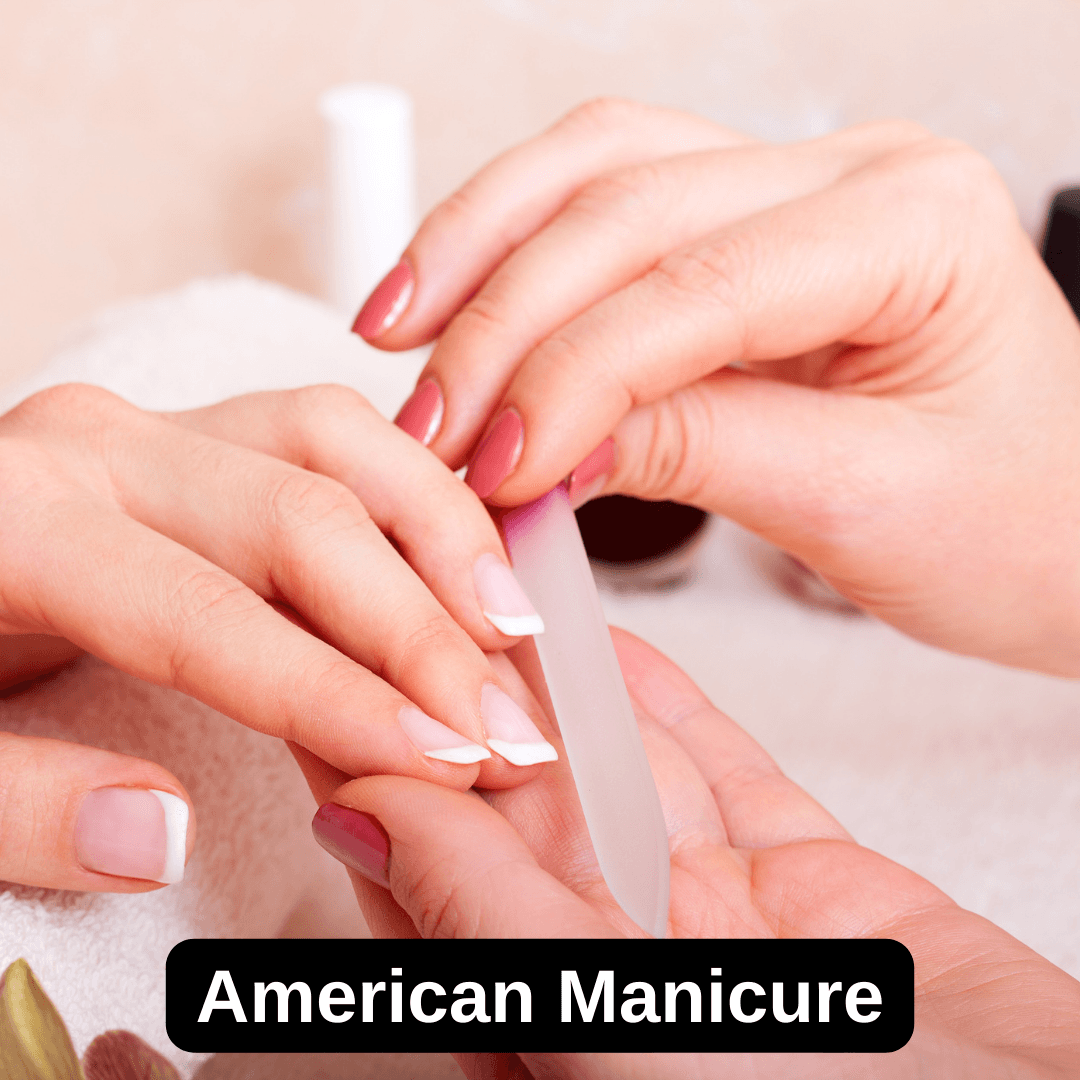
Opt for an American manicure for a polished yet subtle nail finish that complements everyday wear.
What Is a Moon Manicure?
A moon manicure highlights the natural curve or crescent at the base of the nail (the lunula) by leaving it bare or painting it in a contrasting color. This retro style, which gained popularity in the 1920s, has made a modern comeback with contemporary color variations.
Popular Variations:
- Classic Moon Manicures: Featuring neutral shades for a vintage look.
- Bold Color Combinations: Contemporary options with vibrant contrasts.
What Is a Japanese Style Manicure?
A Japanese manicure is a natural nail care technique that uses nutrient-rich pastes and buffing powders to restore and enhance the natural shine of the nails. This method involves gently buffing beeswax or mineral paste into the nails, promoting a glossy, healthy finish without the need for polish.
Key Benefits:
- Strengthens Weak Nails: Improves nail flexibility and prevents breakage.
- Restores Natural Shine: Buffing creates a long-lasting, healthy glow.
- Ideal for Sensitive Nails: Free from harsh chemicals, making it safe for sensitive skin.
What Is a European Manicure Technique?
A European manicure is a dry manicure that focuses on cuticle care and nail shaping without soaking the nails. It uses an electric nail file or gentle manual tools to push back and remove cuticles, allowing for a cleaner and longer-lasting polish application.
Why It’s Popular:
- Prevents Nail Weakening: Avoids weakening caused by excessive soaking.
- Precise Cuticle Work: Allows for more control and precision during cuticle care.
- Long-Lasting Results: Ensures flawless, long-lasting polish application.
This technique is ideal for individuals with sensitive nails who prefer minimal water exposure to prevent weakening or brittleness.
What Is a Mermaid Manicure?
A mermaid manicure features iridescent, holographic, or pearlized finishes that resemble the shimmering colors of a mermaid’s tail. This trend is popular for those who love bold, eye-catching designs that stand out.
How to Achieve It:
- Apply a Pastel or Pearl Base: Choose pastel shades or pearlescent hues to create the desired base.
- Use Iridescent Powders or Chrome Pigments: Apply chrome or holographic powders to add a reflective, multidimensional effect.
- Seal with a High-Shine Top Coat: Finish with a glossy top coat to enhance the shine and maintain the effect longer.
Mermaid manicures often work best with pastel or aqua colors, giving the nails an ethereal, ocean-inspired glow.
What Is a Jessica Manicure?
A Jessica manicure is a specialized nail care system developed by Jessica Vartoughian, designed to treat various nail types with customized formulas. This technique focuses on nourishing and strengthening the nails while offering a long-lasting polish finish.
Why It’s Unique:
- Customized Treatments: Each formula addresses specific nail concerns, including dryness, brittleness, and weakness.
- Promotes Stronger Nails: Regular application strengthens the nail bed and promotes healthier growth.
- Ideal for Damaged Nails: Especially beneficial for individuals looking to repair or restore damaged nails.
Jessica manicures are often recommended for individuals who prefer non-toxic, nutrient-rich formulas to maintain healthier nails.
What Is a Unicorn Manicure?
A unicorn manicure uses chrome powders and pastel shades to create an iridescent, holographic finish that mimics the magical shimmer of a unicorn’s horn. This playful and trendy design is ideal for those who enjoy vibrant, fantasy-inspired nail art.
Pro Tip:
- Maximize Iridescent Effect: Use a white or pastel base color before applying the chrome powder.
- Seal with a Glossy Top Coat: A high-shine top coat enhances the holographic effect and ensures a long-lasting finish.
Unicorn manicures allow for creative expression and vibrant color combinations, making them a favorite among trendsetters.
What Is Nail Slugging?
Nail slugging is a hydrating treatment where nails and cuticles are coated with a thick, occlusive product such as petroleum jelly or cuticle oil to lock in moisture overnight. This process nourishes dry, brittle nails and promotes healthy growth by preventing moisture loss.
How to Do It:
- Apply a Nourishing Oil or Cream: Use a nutrient-rich oil or thick cream on clean nails and cuticles.
- Seal with Petroleum Jelly: Apply a layer of petroleum jelly or a similar occlusive product to lock in moisture.
- Leave Overnight for Maximum Hydration: For best results, leave the treatment on overnight and rinse in the morning.
Nail slugging is an effective method for restoring moisture to dry, damaged nails, especially during colder months.
What Is the Newest Type of Manicure?
The Biab manicure (Builder in a Bottle) is one of the newest trends in the nail industry. This technique involves applying a flexible, strengthening gel that builds and protects the natural nail while promoting growth. Biab manicures provide durability similar to gel polish but are gentler on the nails.
Why It’s Trending:
- Strengthens Natural Nails: Builds strength while maintaining nail flexibility.
- Chip-Resistant Finish: Provides a longer-lasting, durable finish that resists chipping.
- Promotes Nail Growth: Supports natural nail growth while preventing damage.
Biab manicures are becoming increasingly popular due to their ability to combine nail protection with a flawless finish.
What Is the Psychology of Having Nails Done?
Getting a manicure often provides a boost in confidence and emotional well-being. It promotes feelings of self-care and empowerment, enhancing overall mental health. Many individuals report feeling more put-together and polished after a manicure, which can positively impact their mood and confidence levels.
Psychological Benefits:
- Boosts Self-Esteem: Well-groomed nails contribute to a more polished and confident appearance.
- Provides a Stress-Relieving Experience: The process of having nails done is often seen as a form of self-care and relaxation.
- Enhances a Sense of Control and Care: Maintaining nail health through regular manicures fosters a sense of control over one’s appearance.
Regular manicures not only enhance physical appearance but also contribute to improved mental well-being by promoting a sense of calm and satisfaction.
Achieve Perfect Nails with the Right Manicure Routine
Maintaining flawless nails goes beyond regular salon visits — it’s about achieving a balance between care, maintenance, and breaks to ensure long-term nail health. Regardless of whether you opt for a classic manicure or trendy options like Biab or Japanese manicures, understanding how to align your nail care routine with your nail’s natural growth cycle is key to keeping them strong, glossy, and healthy.
Why Consistency Matters
Consistent care prevents common issues such as chipping, peeling, and discoloration. While gel and acrylic manicures can last up to 3 weeks, giving your nails occasional breaks between treatments can strengthen the nail bed and reduce the risk of thinning or brittleness. Overexposure to UV light and harsh chemicals from frequent polish applications can weaken the nails over time, making mindful maintenance essential.
Best Practices for Long-Term Nail Health
To maintain optimal nail health and ensure your manicure lasts longer, follow these best practices:
- Hydrate Cuticles Daily: Regularly apply nourishing oils like jojoba or argan oil to keep the cuticles hydrated, prevent peeling, and promote nail strength.
- Exfoliate and Moisturize Hands: Keeping the skin around your nails smooth prevents dryness and cracking, which can impact nail health. Use a gentle exfoliant and a hydrating lotion for best results.
- Take Breaks from Gel and Acrylics: Allowing your natural nails to breathe between treatments prevents excessive thinning and brittleness. A 2 to 3-week break every 8 to 12 weeks helps restore strength and flexibility.
- Apply a Strengthening Base Coat: When opting for regular manicures, use a nourishing base coat that strengthens the nail plate and prevents damage caused by frequent polish applications.
Tailoring Your Manicure Schedule
To achieve the best results, align your manicure schedule with your nail’s growth cycle and overall health. While regular manicures every 1 to 2 weeks can maintain a polished look, allowing for periodic breaks prevents long-term damage. For gel or acrylic manicures, a 2 to 3-week interval between sessions gives the nails sufficient time to recover.
Explore Healthy Manicure Options
If you’re looking to minimize damage while keeping your nails stylish, consider healthier manicure options such as:
- Biab Manicure (Builder in a Bottle): A flexible, strengthening gel that protects and promotes natural nail growth.
- Japanese Manicure: A nutrient-rich technique that enhances the natural shine of the nails using gentle buffing and vitamin-infused pastes.
- Soft Gel Manicure: Provides long-lasting results while being gentler on the nail plate compared to traditional gel applications.
Long-Term Nail Care for Beautiful Results
When you prioritize consistent care and mindful maintenance, your nails will remain strong, glossy, and polished year-round. By hydrating, exfoliating, and taking occasional breaks, you protect your nails from unnecessary stress while enjoying long-lasting results. Whether you’re experimenting with trendy manicures or sticking to timeless classics, maintaining a well-balanced routine is the key to achieving flawless, healthy nails that look impeccable in every season.
Just as understanding how often to get a pedicure contributes to healthy feet, aligning your manicure routine with your nail’s growth cycle ensures flawless nails year-round.

Certified Laser Hair Removal Specialist & Licensed Laser Practitioner
With 17+ years of hands-on experience in laser hair removal, She is a certified laser practitioner and master trainer with advanced credentials in diode laser systems and women’s skincare. She has led over 200,000 successful sessions, combining deep technical expertise with a strong academic foundation. Known for her professional integrity and results-driven approach, she ensures all guidance is scientifically grounded and client-focused.

